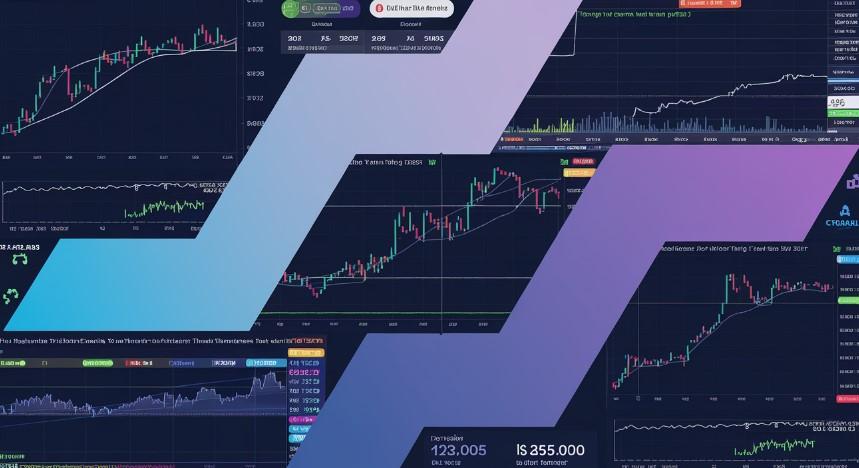A Beginner’s Guide: What is Futures Trading and How S&P 500 Futures Work

If you’ve ever heard terms like "futures trading" or "S&P 500 futures" and wondered what they mean, you're not alone. For beginners, the world of futures can seem complex, intimidating, and filled with jargon. But once you understand the basics, you’ll see that futures trading is not only accessible—it’s one of the most powerful ways to gain exposure to financial markets, hedge risk, and even build a trading career.
In this complete beginner’s guide, we’ll break down:
- What is Futures Trading?
- How S&P 500 Futures work
- Why they’re the most popular contract for retail and institutional traders
- How to get started safely and profitably
By the end, you’ll have a clear, practical understanding of how futures markets operate—and how you can participate with confidence.
✅ What is Futures Trading? A Simple Definition
At its core, futures trading is a way to buy or sell a financial asset at a predetermined price on a future date.
Unlike buying stocks, where you own a piece of a company, futures are contracts—legal agreements between two parties to exchange an asset (like oil, gold, or stock indices) at a set price and date in the future.
Key Features of Futures Contracts:
- Standardized: Every contract has fixed size, expiration, and rules.
- Traded on Exchanges: Such as the CME Group (Chicago Mercantile Exchange).
- Leveraged: You can control large positions with a small amount of capital.
- Settled Daily: Profits and losses are marked-to-market every day.
- Can Be Closed Early: You don’t have to hold until expiration.
💡 Example: You buy 1 E-mini S&P 500 futures contract today at 5,500. If it rises to 5,520 tomorrow, you make money—even if you don’t hold it to expiration.
Why Do People Trade Futures?
Futures are used by three main groups:
|
|
|
|---|---|
|
Hedgers
|
Protect against price changes (e.g., farmers locking in crop prices)
|
|
Speculators
|
Profit from price movements (e.g., traders betting on market direction)
|
|
Arbitrageurs
|
Exploit price differences between markets
|
As a beginner, you’ll likely be a speculator—using futures to profit from market moves.
How Futures Differ from Stocks and Forex
|
|
|
|
|
|---|---|---|---|
|
Ownership
|
Yes (shares)
|
No
|
No (contract)
|
|
Leverage
|
Low to moderate
|
Very high
|
High (but regulated)
|
|
Trading Hours
|
6.5 hours/day
|
24/5
|
23 hours/day
|
|
Expiration
|
No
|
No
|
Yes (monthly/quarterly)
|
|
Regulation
|
SEC
|
CFTC/NFA
|
CFTC/NFA
|
Futures offer the best of both worlds: high liquidity, tight regulation, and near-24-hour access.
✅ What Are S&P 500 Futures? The Most Traded Contract in the World
Now that you understand what is futures trading, let’s dive into the most popular contract: S&P 500 Futures.
The S&P 500 Index tracks the performance of 500 of the largest U.S. companies, including Apple, Microsoft, Amazon, and Tesla.
S&P 500 Futures are futures contracts based on this index.
They allow traders to speculate on or hedge against the overall direction of the U.S. stock market—without buying individual stocks.
Why S&P 500 Futures Are So Popular
|
|
|
|---|---|
|
High Liquidity
|
Over 3 million contracts traded daily—tight spreads, low slippage
|
|
Market Representation
|
Reflects the health of the U.S. economy
|
|
Predictable Volatility
|
Moves with earnings, interest rates, and inflation data
|
|
23-Hour Trading
|
Trade after hours, weekends (almost), and global sessions
|
|
Scalable Contracts
|
From micro to institutional size
|
🔍 Fact: S&P 500 futures are the most traded equity index futures contract in the world.
The Three Main S&P 500 Futures Contracts
There are three versions of S&P 500 futures—each designed for different types of traders.
|
|
|
|
|
|
|
|---|---|---|---|---|---|
|
ES
|
E-mini S&P 500
|
ES
|
$12.50
|
$50
|
Most traders, retail & institutional
|
|
SP
|
Big S&P 500
|
SP
|
$250
|
$250
|
Institutional traders only
|
|
MES
|
Micro E-mini S&P 500
|
MES
|
$1.25
|
$5
|
Beginners, small accounts
|
Let’s break them down.
1. ES – E-mini S&P 500 Futures (The Gold Standard)
The ES contract is the most traded equity futures contract globally.
Key Features:
- Contract Multiplier: 50 x S&P 500 Index
- Tick Size: 0.25 index points = $12.50 per tick
- Trading Hours: 6:00 PM – 5:00 PM ET (CME Globex)
- Margin Requirement: ~$12,000–$15,000 (varies by broker)
💡 Example: If the S&P 500 is at 5,500, one ES contract controls $275,000 (50 x 5,500).
Why Traders Love ES:
- High liquidity = minimal slippage
- Ideal for day trading, swing trading, and scalping
- Supported by all major futures trading platforms
- Used by hedge funds, prop firms, and retail traders
2. SP – Big S&P 500 Futures (Institutional Only)
The SP contract is the original S&P 500 futures contract, launched in 1982.
Key Features:
- Contract Multiplier: 250 x S&P 500 Index
- Tick Size: 0.10 index points = $25 per tick
- Not liquid compared to ES
- Margin Requirement: $250,000+
This contract is rarely traded today—used only by large institutions.
✅ Note: As a beginner, you’ll never trade SP. But it’s important to know it exists.
3. MES – Micro E-mini S&P 500 Futures (Perfect for Beginners)
Introduced in 2019, the MES contract is a smaller, beginner-friendly version of ES.
Key Features:
- Contract Multiplier: 5 x S&P 500 Index
- Tick Size: 0.25 index points = $1.25 per tick
- Margin Requirement: ~$1,200–$1,800
- Same price action as ES
Why MES Is Ideal for Beginners:
- 1/10th the size of ES → Lower risk
- Same charts, same trends
- Great for learning without blowing up your account
- Accepted by most futures trading prop firms
✅ Pro Tip: Use MES to test your ES strategy with 90% less risk.
How S&P 500 Futures Move: What Drives the Market?
Unlike commodities (e.g., oil or gold), S&P 500 futures move with macroeconomic forces and market sentiment.
Key drivers include:
|
|
|
|---|---|
|
Interest Rates (Fed Policy)
|
Higher rates → Lower stock valuations
|
|
Inflation (CPI, PPI)
|
High inflation → Fed hikes → Market down
|
|
Earnings Reports
|
Strong earnings → Market up
|
|
Geopolitical Events
|
Crises → Risk-off → Market down
|
|
Unemployment (NFP)
|
Low unemployment → Strong economy → Market up
|
🔔 Pro Tip: Always check the economic calendar before trading.
✅ How to Start Trading S&P 500 Futures (Step-by-Step for Beginners)
Now that you know what is futures trading and how S&P 500 futures work, here’s how to get started—safely and confidently.
Step 1: Choose the Right Contract
For beginners: Start with MES (Micro E-mini S&P 500).
- Lower risk
- Smaller margin
- Same price action as ES
- Perfect for learning
🚫 Never start with ES—it’s too risky for new traders.
Step 2: Pick a Futures Broker & Platform
Top brokers for beginners:
- Tradovate – Low-cost, Thinkorswim-like platform
- NinjaTrader – Free platform, low commissions
- TradeStation – Professional tools, integrates with prop firms
- Thinkorswim (TD Ameritrade) – Free access, excellent education
✅ Pro Tip: Use Thinkorswim’s paperMoney to practice risk-free.
Step 3: Learn the Basics of Technical Analysis
You don’t need 10 indicators. Start with:
- Support & Resistance
- Trendlines
- Moving Averages (200 EMA)
- Volume
✅ Simple Strategy: Buy when price is above 200 EMA and pulls back to 50 EMA.
Step 4: Master Risk Management
This is the #1 reason beginners fail.
Golden Rules:
- Risk 1% of your account per trade
- Use hard stop-loss and take-profit
- Never move a stop-loss
- Avoid revenge trading
💬 Example: $5,000 account → $50 max risk → 40 ticks stop on MES → $50 loss if stopped out.
Step 5: Paper Trade First
- Trade 50+ paper trades with consistent results
- Keep a trading journal (entry, exit, reason, emotion)
- Only go live when you’re consistently profitable
📝 Pro Tip: Screenshot every trade and write: “Why did I take this?”
Step 6: Go Live with Real Capital (Small Size)
- Start with 1 MES contract
- Trade only during 9:30–11:30 AM EST (high momentum)
- Avoid news events (CPI, FOMC)
- Focus on consistency, not big wins
✅ Common Beginner Mistakes to Avoid
|
|
|
|
|---|---|---|
|
Trading ES too soon
|
Large losses
|
Start with MES
|
|
No stop-loss
|
Account blowup
|
Always set hard stops
|
|
Overtrading
|
Emotional decisions
|
Trade only 1–3 times/day
|
|
Holding overnight
|
Gap risk
|
Close all positions before 5 PM ET
|
|
Ignoring news
|
Slippage, volatility
|
Avoid trading during CPI, FOMC, NFP
|
✅ Final Thoughts: What is Futures Trading? It’s Your Gateway to the Markets
What is Futures Trading?
It’s a powerful, regulated, and accessible way to trade the world’s most important financial markets.
And S&P 500 Futures are the perfect starting point—liquid, predictable, and widely analyzed.
Start with MES, use a simple strategy, and master risk management.
Trade small.
Learn deeply.
Grow steadily.
Because in futures, survival beats brilliance.
- Seo
- Art
- Causes
- Crafts
- Dance
- Drinks
- Film
- Fitness
- Food
- Jocuri
- Gardening
- Health
- Home
- Literature
- Music
- Networking
- Alte
- Party
- Religion
- Shopping
- Sports
- Theater
- Wellness
- Business & Money

